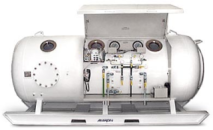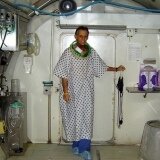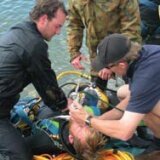Healing Wounds References
1. Reiber GE, Boyko EJ, Smith DG. Chapter 18. Lower extremity foot ulcers and amputations in diabetes. In. Daibetes in America, 2nd ed. National Diabetes Data Group, National Institutes of Health, National Institute of Diabetes and Digestive and Kidney Diseases, NIH Publication No. 95-1468, 1995; 409-428.
2. Lazarus GS, Cooper DM, Knighton DR et al. Definitions and guidelines for assessment of wounds and evaluation of healing. Arch Derm 1994;130(4):489-493.
3. Hunt TK, Twomey P, Zederfeldt B, Dunphy JE. Respiratory gas tensions and pH in healing wounds. Am J Surg 1967;114:302-307.
4. Niinikoski J. Effect of oxygen supply on wound healing and formation of experimental granulation tissue. Acta Physiol Scand 1969; 334:1-72.
5. Sheffield, PJ. Tissue oxygen measurements with respect to soft-tissue wound healing with normobaric and hyperbaric oxygen. HBO Rev 1985;6:18-46.
6. Sheffield PJ, Workman WT. Noninvasive tissue oxygen measurements in patients administered normobaric and hyperbaric oxygen by mask. HBO Rev 1985;6:47-62.
7. Sheffield, P. Tissue oxygen tension. In: Davis JC, Hunt TK, eds. Problem Wounds: The Role of Oxygen. New York: Elsevier, 1988:17-51.
8. Hunt TK, Pai MP. The effect of varying ambient oxygen tensions on wound metabolism and collagen synthesis. Surg Gynecol Obstet 1972;135:561-567.
9. Knighton D, Silver I, Hunt TK. Regulation of wound healing angiogenesis-effect of oxygen gradients and inspired oxygen concentration. Surgery 1981;90:262-270.
10. Knighton DR, Oredsson S, Banda M, Hunt TK. Regulation of repair: Hypoxic control of macrophage mediated angiogenesis. In: Hunt TK, Heppenstall RB, Pine E, Rovee D, eds. Soft and Hard Tissue Repair. New York: Praeger, 1984:41-49.
11. La Van FB, Hunt TK. Oxygen and wound healing. Clinc Plast Surg 1990:17(3):463-472.
12. Robson MC, Stenberg BD, Heggers JP. Wound healing alterations caused by infection. Clin Plast Surg 1990;17(3):485-492.
13. Grief R, Akca O, et al. Supplemental perioperative oxygen to reduce the incidence of surgical-wound infection. NEJM 2000;342(3):61-167.
14. Rabkin J, Hunt TK. Infection and oxygen. In: Davis JC, Hunt TK eds. Problem Wounds: The Role of Oxygen. New York: Elsevier, 1988:1-16.
15. Hunt TK. The physiology of wound healing. Ann Emerg Med 1988;17:1265-1273.
16. Silver IA. Cellular microenvironment in healing and non-healing wounds. In: Hunt TK, Heppenstall RB, Pines E, Rovee D, eds. Soft and hard tissue repair. New York: Praeger, 1984:50-66.
17. Niinikoski J, Hunt TK, Zederfeldt B. Oxygen supply in healing tissue. Am J Surg 1972;123:247-252.
18. Scheffler A, Rieger H. Clinical information content of transcutaneous oxymetry (tcpO2) in peripheral arterial occlusive disease (A review of the methodological and clinical literature with a special reference to critical limb ischemia). VASA, Band 1992;21:111-126.
19. Matos LA, Nunez AA. Enhancement of healing in selected problem wounds. In: Kindwall EP, ed. Hyperbaric Medicine Practice. Flagstaff AZ: Best Publishing 1994;589-612.
20. Sheffield, PJ. Measuring tissue oxygen tension: A review. Undersea Hyperbaric Med 1998;25:179-188.
21. Steenfos HH, Baumbach P. Transcutaneous pO2 in peripheral vascular disease. Radiometer Copenhagen TC105.
22. Hanna GP, Fuise K, Kjellgren O, Feld S, Fife C, Schroth G, Clanton T, Anderson V, Smalling RW. Infrapopliteal transcatheter interventions for limb salvage in diabetic patients: Importance of aggressive interventional approach and role of transcutaneous oximetry. J Am Coll Cardiol 1997;30:664-669.
23. Achauer BM, Black KS, Litke DK. Transcutaneous PO2 in flaps: a new method of survival prediction. Plastic Reconstruct Surg 1980;65(6):738-744.
24. Hauser CJ, Klein SR, Mehringer CM, et al. Superiority of transcutaneous oximetry in noninvasive vascular diagnosis in patients with diabetes. Arch Surg 1984;119:690-694
25. Christensen KS, Klarke M. Transcutaneous oxygen measurement in peripheral occlusive disease. J Bone Joint Surg. 1986;68-B(3):423-426.
26. Malone JM, Anderson GG, Lalka SG, et al. Prospective comparison of noninvasive techniques for amputation level selection. Amer J Surg 1987;154:179-184.
27. Wyss CR, Harrington RM, Burgess EM, et al. Transcutaneous oxygen tension as a predictor of success after an amputation. J Bone Joint Surg 1988;70-A(2),203-207.
28. Ameli FM, Stein M, Provan JL, et al. Comparison between transcutaneous oximetry and ankle-brachial pressure ratio in predicting runoff and outcome in patients who undergo aortobifemoral bypass. CJS, 1989;33(6):428-432
29. Padberg FT, Black TL, Thompson PN, Hobson RW. Transcutaneous oxygen (TcPO2) estimates probability of healing in the ischemic extremity. J Surg Res 1996;60:263-268.
30. Wutschert R, Bounameaux H. Determination of amputation level in ischemic limbs. Reappraisal of the measurement of TcPo2. Diabetes Care 1997;20(8):1315-8.
31. Faglia E, Favales F. Aldeghi A, Calia P, Quarantiello P, Barbano A. Change in major rate in a center dedicated to diabetic foot care in the 1980s: prognostic determinants for major amputations. J Diabetes Complications 1998:12(2):96-102.
32. Ballard JL, Eke CC, Bunt TJ, Killeen JD. A prospective evaluation of transcutaneous oxygen measurements in the management of diabetic foot problems. J Vasc Surg 1995;22(4):485-492.
33. Kalani J, Brismar K, Fagrell B, Ostergren J, Jorneskog G. Transcutaneous oxygen tension and toe blood pressure as predictors for outcome of diabetic foot ulcers. Diabetes Care 1999;22(1):147-151.
34. Bacharach JM, Rooke TW, Osmundson PJ, Gloviczki P. Predictive value of transcutaneous oxygen pressure and amputation success by use of supine and elevation measurements. J Vasc Surg 1992;15:558-563.
35. Hauser CJ, Appel P, Shoemaker WC. Pathophysiologic classification of peripheral vascular disease by positional changes in regional transcutaneous oxygen tension. Surgery 1993;95(6):689-693.
36. Kram HB, Appel PL, White RA, Shoemaker WC. Assessment of peripheral vascular disease by postocclusive transcutaneous oxygen recovery time. J Vasc Surg 1984;1:628-634.
37. Harward TRS, Volny J, Golbranson F, Bernstein, EF, Fronek A. Oxygen inhalation-induced transcutaneous PO2 changes as a predictor of amputation level. J Vasc Surg 1985;2:220-227.
38. Fife CF, Buyukcakir C, Otto GH, Sheffield PJ, Warriner RA, Love TL, Mader J. The predictive value of transcutaneous oxygen tension measurement in diabetic lower extremity ulcers treated with hyperbaric oxygen therapy: a retrospective analysis of 1144 patients. Wound Rep Reg 2002;10:198-207.
39. Wattel F, Mathieu D, Coget JM. Prediction of final outcome with transcutaneous oxygen measurements of problem wounds treated with hyperbaric oxygen. Proceedings, 2nd European Conference on Hyperbaric Medicine, Basel, 1990;221-223.
40. Wattel FE, Mathieu DM, Fossati P, Neviere RR, Coget JM. Hyperbaric oxygen in the treatment of diabetic foot lesions search for healing predictive factors. J Hyperbaric Med 1991;6(4):263-268.
41. Smith BM, Desvigne LD, Slade JB, Dooley JW, Warren DC. Transcutaneous oxygen measurements predict healing of leg wounds with hyperbaric therapy. Wound Rep Reg 1996;4:224-229.
42. Pecoraro RE, Ahroni JH, Boyko EJ, Stensel VL. Chronology and determinants of tissue repair in diabetic lower-extremity ulcers. Diabetes 1991;40:1305-1313.
43. Wang C, Lau J. Hyperbaric Oxygen Therapy in Treatment of Hypoxic Wounds. Technology Assessment. Agency for Healthcare Research and Quality (AHRQ). November 2, 2001. USA.
44. CAG-00060N Coverage Decision Memorandum for Hyperbaric Oxygen Therapy in the Treatment of Hypoxic Wounds and Diabetic Wounds of the Lower Extremities. Center for Medicare and Medicaid Services August 30, 2002.
45. Mandell G. Bacteriacidal activity of aerobic and anaerobic polymorphonuclear neutrophils. Infect Immun 1974;9:337-341.
46. Mader JT, Brown GL, Guckian JC, et al. A mechanism for the amelioration by hyperbaric oxygen of experimental staphylococcal osteomyelitis in rabbits. J Infect Dis 1980;142:915-922.
47. Mader JT, Adams KR, Sulton TE. Infectious diseases: pathophysiology and mechanisms of hyperbaric oxygen. J Hyperbaric Med1987; 2:133-140.
48. Adams KR, Mader JT. Aminoglycoside potentiation with adjunctive hyperbaric oxygen therapy in experimental Pseudomonas aeruginosa osteomyelitis. Undersea Hyperbaric Medical Society Annual Scientific Meeting, 1987;Abstract 70.
49. Adams KR, Sutton TE, Mader JT. In vitro potentiation of tobramycin under hyperoxic conditions. Undersea Hyperbaric Medical Society Annual Scientific Meeting, 1987;Abstract 69.
50. VanUnnik AJM. Inhibition of toxin production in Clostridium perfringens in vitro by hyperbaric oxygen. Antonie Van Leeuwenhoek 1965;31:181-186.
51. Luongo C, Imperatore F, Cuzzocrea S, Filippelli A, Scafuro MA, Mangoni G, Portolano F, Rossi F. Effects of hyperbaric oxygen exposure on a zymosan-induced shock model. Crit Care Med 1998;26:1972-1976.
52. Zamboni WA, Roth AC, Russell RC, et al. The effect of acute hyperbaric oxygen therapy on axial pattern skin flap survival when administered during and after total ischemia. J Reconstr Microsurg 1989;5:343-347.
53. Zamboni WA, et al. Morphologic analysis of the microcirculation during reperfusion of ischemic skeletal muscle and the effects of hyperbaric oxygen. Plast Reconstr Surg 1993;91 1110-1123.
54. Thom SR. Functional inhibition of leukocyte B2 integrins by hyperbaric oxygen in carbon monoxide-mediated brain injury in rats. Toxicol Appl Pharmacol 1993;123:248-256.
55. Sheikh AY, Gibson JL, Rollins MD, Hopf HW, Hussain Z, Hunt TK. Effect of hyperoxia on vascular endothelial growth factor levels in a wound model. Arch Surg 2000;135:1293-1297.
56. Zhao LL, Davidson JD Wee SC, Roth SI, Mustoe TA. Effect of hyperbaric oxygen and growth factors on rabbit ear ischemic ulcers. Arch Surg 1994;129:1043-1049.
57. Siddiqui A, Davidson JD, Mustoe TA. Ischemic tissue oxygen capacitance after hyperbaric oxygen therapy: A new physiologic concept. Plast Reconstr Surg 1997 99:148-155
58. Bonomo SR, Davidson JD, Yu Y, Yja Y, Lin, Mustoe TA. Hyperbaric oxygen as a signal transducer: upregulation of platelet derived growth factor-beta receptor in the presence of HBO, and PDGF. Undersea Hyper Med 1998;25(4)211-216.
59. Ketchum SA III, Thomas AN, Hall AD. Angiographic studies of the effects of hyperbaric oxygen on burn wound revascularization, In: Proceedings of the Fourth International Congress in Hyperbaric Medicine (J Wada, T Iwa, eds), Williams and Wilkins, Baltimore, 1969 388-394.
60. Ramsey SD, Newton K, Blough D, McCulloch DK, Sandhu N, Reiber GE, Wagner EW. Incidence, outcomes, and cost of foot ulcers in patients with diabetes. Diabetes Care 1999;22:382-387.
61. Reiber GE, Pecoraro RE, Keopesell TD. Risk factors for amputation in patients with diabetes mellitus. Ann Int Med 1992;117:97-105.
62. Reiber GE, Vileikyte L, Boyko EJ, Aguila M, Smith DG, Lavery LA, Boulton AJM. Causal pathways for incident lower-extremity ulcers in patients with diabetes from two settings. Diabetes Care 1999;22:157-162.
63. Caputo GM, Cavanagh PR, Ulbrecht JS, Gibbons GW, Karchmer AW. Assessment and management of foot disease in patients with diabetes. Current concepts. NEJM 1994;331(13):854-860.
64. American Diabetes Association. Consensus Development Conference on Diabetic Foot Wound Care. Diabetes Care 1999;22(8):1354-1360.
65. Mason J, O’Keeffe C, McIntosh A, Hutchinson A, Booth A, Young RJ. A systematic review of foot ulcer in patients with Type 2 diabetes mellitus. II: treatment. Diabet Med 1999;16:889-909.
66. Han P, Ezquerro R. Diabetic foot wound care algorithms. J Am Podiatr Med Assoc 2002;92(6):336-349.
67. Gibbons GW, Marcaccio EJ Jr, Burgess AM, Pomposelli FB Jr, Freeman DV, Campbell DR, Miller A, LoGerfo FW. Improved quality of diabetic foot care, 1984 vs. 1990. Arch Surg 1993;128:576-581.
68. Akbari CM, Pomposelli FB, Gibbons GW, Campbell DR, Pulling MC, Mydlarz D, LoGerfo FW. Lower extremity revascularization in diabetes late observations. Arch Surg 2000;125:452-456.
69. Smiell JM, Wieman J, Steed DL, Perry BH, Sampson AR, Schwab BH. Efficacy and safety of becaplermin (recombinant human platelet-derived growth factor-BB) in patients with nonhealing, lower extremity diabetic ulcers: a combined analysis of four randomized studies. Wound Rep Reg 1999;7:335-346.
70. Gentzkow GD, Iwasaki SD, Herson KS, Mengel M, Prendergast JJ, Ricotta JJ, Steed DP, Lipkin S. Use of dermagraft, a cultured human dermis, to treat diabetic foot ulcers. Diabetes Care 1996;19(4):350-354.
71. Gentzkow GD, Jensen JL, Pollak RA, Kroeker RO, Lerner JM, Lerner M, Iwasaki SD. Improved healing of diabetic foot ulcers after grafting with a living human dermal replacement. Wounds 1999;11(3):77-84.
72. Hanft JR, Surprenant MS. Healing of chronic foot ulcers in diabetic patients treated with a human fibroblast-derived dermis. J Foot & Ankle Surg 2002;41(5):291-299.
73. Pham HT, Rosenblum BI, Lyons TE, Giurini JM, Chrzan JS, Habershaw GM, Veves A. Evaluation of a human skin equivalent for the treatment of diabetic foot ulcers in a prospective, randomized, clinical trial. Wounds 1999;11(4):79-86.
74. Veves A, Falanga V, Armstrong DG, Saboinski ML. Graftskin, a human skin equivalent, is effective in the management of noninfected neuropathic diabetic foot ulcers: A prospective randomized multicenter clinical trial. Diabetes Care 2001;24:290-295.
75. McCallon SK, et al. Vacuum-assisted closure vs saline-moistened gauze in the healing of postoperative diabetic foot wounds. Ostomy/Wound Management, 2000;46(8):28-34.
76. Armstrong DG, et al. Outcomes of subatmospheric pressure dressing therapy on wounds of the diabetic foot. Ostomy/Wound Management. 2002;48:64-68.
77. Knighton DR, Fylling CP, Fiegel VD, Cerra F. Amputation prevention in an independently reviewed at-risk diabetic population using a comprehensive wound care protocol. Am J Surg 1990;160:466-472.
78. Hyperbaric Oxygen Therapy for Wound Healing – Part I. Blue Cross Blue Shield Association TEC, Technology Assessment, August 1999. USA.
79. Hyperbaric Oxygen Therapy. Australian Medicare Service Advisory Committee (MSAC). Technology Assessment. April 2000. Canberra, Australia.
80. Hopf H, West J. Arterial subcommittee: Should hyperbaric oxygen therapy be utilized in the control arm of clinical research studies of arterial (ischemic) wounds? Provisional Guidelines for Chronic Wound Care: Arterial, Diabetic, Pressure and Venous. WOCN/WHS June 21, 1999.
81. Care of diabetic foot ulcer. British J Med Clinical Evidence Issue 5 and subsequent, June 2001.
82. Wang C, Schwaitzberg S, Berliner E, Zarine DA, Lau J. Hyperbaric oxygen for treating wounds. A systematic review of the literature. Arch Surg 2003;138:272-279.
83. Wagner FW. The dysvascular foot: A system for diagnosis and treatment. Foot & Ankle 1981;2(2):64-122.
84. Smith RG. Validation of Wagner’s classification: a literature review. Ostomy/Wound Management 2003;49(1):54-62.
85. Doctor N, Pandya S, Supe A. Hyperbaric oxygen therapy in diabetic foot.J Postgrad Medicine 1992;38(3):112-114.
86. Faglia E, et al. Adjunctive systemic hyperbaric oxygen therapy in the treatment of diabetic foot ulcer. A randomized study. Diabetes Care 1996;19:1338-1343.
87. Abidia A, Kuhan G, Laden G, et al. Hyperbaric Oxygen therapy for diabetic leg ulcers – a double blind randomized controlled trial. Undersea Hyperbaric Med 2001;28(Suppl):64 (abstract)
88. Kalani M, Jorneskog G, Naderi N, Lind F, Brismar K. Hyperbaric oxygen (HBO) therapy in treatment of diabetic foot ulcers long-term follow-up. J Diabetes and Its Complications 2002;16:153-158.
89. Goldman MP, Fronek A. Consensus paper on venous leg ulcer. J Dermatol Surg Oncol 1992;18:592-602.
90. Moffatt CJ, O’Hare L. Venous leg ulceration:Treatment by high compression bandaging. Ostomy/Wound Management 1995;41(4):16-25.
91. Falanga V, Margolis D, Alvarez O, Auletta M, Maggiacomo F, Altman M, Jensen J, Sabolinski M, Hardin-Young J. Rapid healing of venous ulcers and lack of clinical rejection with an allogeneic cultured human skin equivalent. Arch Dermatol 1998;293-300.
92. Hammarlund C, Sundberg T. Hyperbaric oxygen reduced size of chronic leg ulcers: A randomized double blind study. Plast Reconstr Surg 1994;93:829-834.
93. Treatment of pressure ulcers. Clinical Practice Guideline Number 15. U.S. Dept of Health and Human Services, Agency for Health Care Policy and Research Publication No. 95-0652, December 1994.
94. Davis JC, Buckley CJ, Barr PO. Compromised soft tissue wounds: Correction of wound hypoxia. In: Davis JC, Hunt TK, eds. Problem Wounds: The Role of Oxygen. New York: Elsevier. 1988:143-152.
95. Hyperbaric oxygen therapy: Its use and appropriateness OEI-06-09-00090. Dept of Health and Human Services, Office of the Inspector General, 2000.
96. Cianci P, Petrone G, Drager S. Lueders H, Lee H, Shapiro R. Salvage of the problem wound and potential amputation with wound care and adjunctive hyperbaric oxygen therapy: An economic analysis. J Hyperbaric Med 1988;3(3):127-141.
97. Cianci P, Petrone G, Green B. Adjunctive hyperbaric oxygen in the salvage of the diabetic foot. Undersea Biomed Res 1991;18(Suppl):108.
98. Cianci P, Hunt TK. Long term results of aggressive management of diabetic foot ulcers suggest significant cost effectiveness. Wound Rep Regen 1997;5:141-146.
99. Lin TF, Chen SB, Niu KC. The vascular effects of hyperbaric oxygen therapy in treatment of early diabetic foot. Undersea Hyperbaric Med 2001;28(Suppl):67 (abstract)
100. Zamboni W, Wong H, Stephenson L, et al. Evaluation of hyperbaric oxygen for diabetic wounds: a prospective study. Undersea Hyperbaric Med 1997;24(3):175-179.
101. Baroni G, Porro T, Faglia E, et al. Hyperbaric oxygen in diabetic gangrene treatment. Diabetes Care 1987;10(1):81-86.
102. Davis JC. The use of adjuvant hyperbaric oxygen in the treatment of the diabetic foot. Clin Pod Med Surg 1987; 4(2):429-437.
103. Oriani G, Meazza D, Favales F, et al. Hyperbaric oxygen therapy in diabetic gangrene. J Hyperbaric Med 1990;5(3):171-175.
104. Wattel FE, Mathieu DM, et al. Hyperbaric oxygen in the treatment of diabetic foot lesions: Search for healing predictive factors. J Hyperbaric Med 1991;6(4):263-268.
105. Oriani G, Michael M, Meazza D, et al. Diabetic foot and hyperbaric oxygen therapy: A ten-year experience. J Hyperbaric Med 1992;7(4):213-221
106. Stone JA, Scott RG, Brill LR, Levine BD. The role of hyperbaric oxygen therapy in the treatment of the diabetic foot. Diabetes, 1995;44(Suppl 1): 71A.
107. Faglia E.. Change in major amputation rate in a center dedicated to diabetic foot care during the 1980s: prognosis determinants for major amputation. J Diabetes Comp 1998;2:96-102











